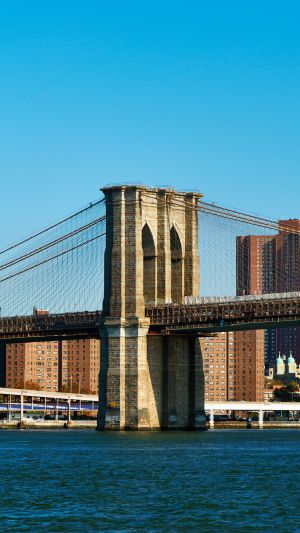The Brooklyn Bridge stands as one of New York City's most iconic landmarks, connecting the boroughs of Manhattan and Brooklyn across the East River.
Since its completion in 1883, this magnificent structure has served not only as a vital transportation hub for the city but also as a masterpiece of architecture and engineering. It stands as a symbol of the Industrial Revolution's remarkable achievements.
The construction of the Brooklyn Bridge began in 1869, with its design attributed to the German immigrant engineer John A. Roebling. Roebling envisioned a cable-suspended bridge, capable of spanning the vast distance required to cross the East River.
Unfortunately, Roebling tragically died in an accident before the construction began, leaving his son, Washington Roebling, to take on the monumental task of overseeing the project as the chief engineer.
Washington Roebling faced significant challenges, including severe health issues that arose during the construction. In a remarkable turn of events, his wife, Emily Roebling, took over much of the command and responsibility, ensuring that the bridge was eventually completed.
The Brooklyn Bridge stretches a total length of approximately 1,834 meters, with its main span reaching 486 meters. Upon completion, it became the longest suspension bridge in the world.
The design of the bridge not only set new records in terms of length but also introduced a unique double-deck structure. The upper deck was designated for pedestrians and bicycles, while the lower deck was reserved for motor vehicles.
This innovative design not only enhanced traffic efficiency but also provided pedestrians with a breathtaking opportunity to enjoy the scenic views on both sides of the East River.
Throughout its construction, the Brooklyn Bridge faced numerous technical and natural challenges. The bridge's foundation was built on the riverbed of the East River, a task that required workers to dig deep into the riverbed and lay the foundation under extremely harsh conditions.
This arduous process led to many workers suffering from decompression sickness, also known as "the bends," including Washington Roebling himself.
In addition to the challenges of laying the foundation, the production and installation of the bridge's steel cables presented a complex and demanding task that required precise calculations and advanced technology.
Despite these obstacles, the successful resolution of these technical challenges ultimately made the Brooklyn Bridge a marvel in the engineering world.
The completion of the Brooklyn Bridge significantly improved the traffic conditions in New York City and became a symbol of technological progress and human ingenuity.
When the bridge was officially opened to the public, thousands of New Yorkers flocked to its deck to witness the unveiling of this extraordinary structure. The cable-suspended design, the majestic stone towers, and the harmonious beauty of the overall construction left a lasting impression on all who beheld it.
Today, the Brooklyn Bridge continues to serve as an essential transportation route in New York City, while also attracting travel enthusiasts and photographers from around the world.
Whether bathed in the morning light or illuminated by the glow of nighttime lights, the Brooklyn Bridge exudes a unique charm that captivates visitors. Walking across the bridge, one can take in panoramic views of the Manhattan skyline and feel the vibrant energy of the city.
In addition to its practical and aesthetic significance, the Brooklyn Bridge has been immortalized in literature, film, and art, becoming a quintessential symbol of New York culture. It represents not only the innovation of architectural technology but also the rich history and promising future of New York as a global metropolis.
The Brooklyn Bridge stands as a major milestone in the history of architecture and engineering, bearing witness to the great achievements of the Industrial Revolution. It has become a symbol of New York City and, indeed, of the entire United States.
Today, whether regarded as a functional bridge or a cultural icon, the Brooklyn Bridge continues to capture the attention of people from all walks of life, telling its legendary story to each new generation.





